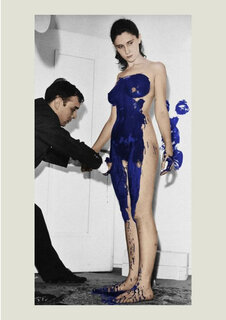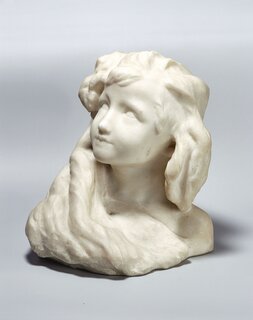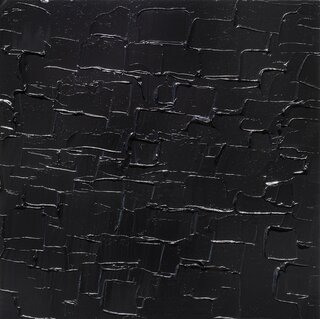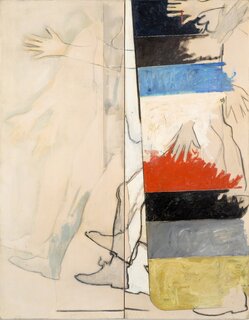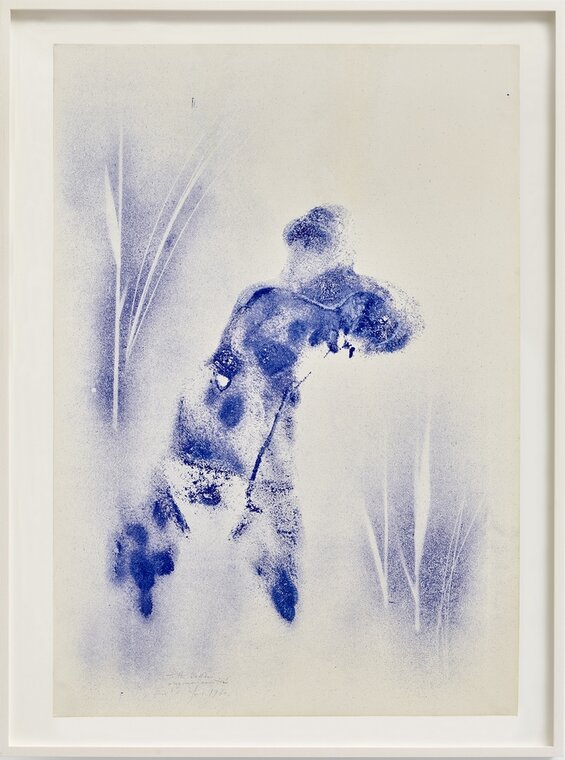
"Only the body is alive, all-powerful, and non-thinking.... The heart beats without thought on our part; the mind cannot stop it, digestion works without our intervention, be it emotional or intellectual. We breathe without reflection. True, the whole body is made of flesh, but the essential mass is the trunk and the thighs. It is there that we find the real universe, hidden by the universe of our limited perception.
—Yves Klein
Yves Klein first used a female model as a “living paintbrush” during a performance before a select group of friends in Paris in June of 1958. He made a focused return to this mode of artmaking in 1960, and it was at this time, after witnessing the artist creating the painted imprints of two models at his studio at 14 rue Campagne–Première, that Pierre Restany would term these works Anthropométrie, after the study of human body measurements.
To compose these dynamic paintings, Klein painted his models with International Klein Blue (his patented blue hue), directing and moving their bodies as they made imprints on large sheets of paper. The Anthropométries represented an advancement of Klein’s philosophy, analogous yet different from that of his monochromes. During a time which saw the dominance of Taschisme and Abstract Expressionism in art critical discourses, Klein sought unique ways of distinguishing the painterly gesture. Through his Anthropométries, Klein discovered a manner of painting that was more connected to a shared, corporeal experience than the singularity of an individual.
While a radical departure, Klein’s Anthropométries are rich in art historical reference. Klein’s imprints of the human form, left identifiable only by the contours of models’ torsos and thighs, recall numerous Greco-Roman marble figures, such as the Belvedere Torso (circa 1st century BCE), a sculpture revered by Michelangelo and other artists of the Renaissance. Beyond his Anthropométries, Klein’s fascination with classical sculpture is further evinced in his sculptural Blue Venus and Victoire de Samothrace (both 1962), covered in layers of International Klein Blue paint. The present work, Anthropométrie sans titre (ANT 162) (1960) offers an ethereal precursor; in its central register, the composition features the gracefully arched imprint of the model, powerfully emerging between two sprays of slender leaves, which evoke the effects of mid-nineteenth century cyanotypes. Thus, melding flora and fauna, Klein captures in ANT 1962 the timeless nature of the physical fragment and the indexical immediacy of living, breathing forms.
Examples from the Anthropométrie series can be found in numerous important museum collections, including the Centre Pompidou, Paris; Fondation Carmignac, Porquerolles, France; Hirshhorn Museum and Sculpture Garden, Washington, DC; Iwaki City Art Museum, Fukushima, Japan; Leeum, Samsung Museum of Art, Seoul; Louvre Abu Dhabi; Musée d'Art Moderne et d'Art Contemporain, Nice; Guggenheim Bilbao; Museum Ludwig, Cologne; Museum of Modern Art, New York; San Francisco Museum of Modern Art; and Tokyo Metropolitan Art Museum. "

